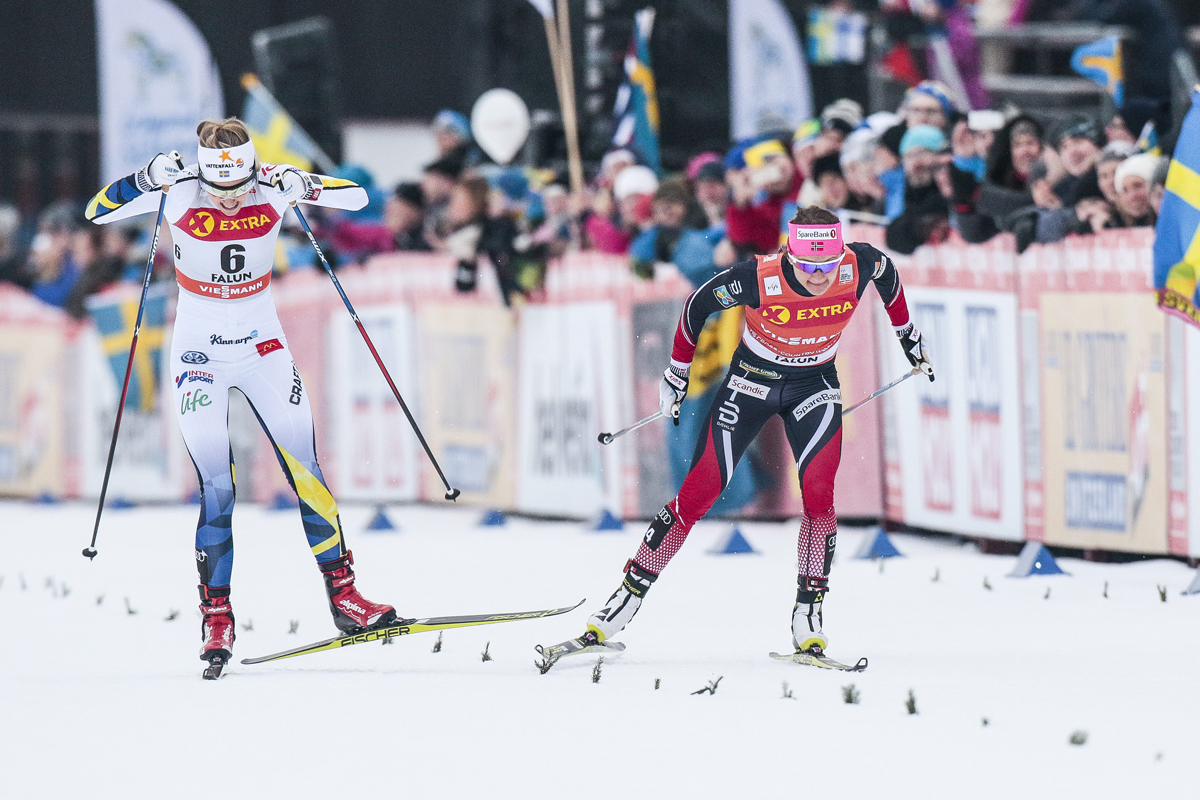
This was a definitive comment on the FIS Cross-Country Skiing Facebook page: “literally 1mm of toenail.”
Photo finish doesn’t fully describe the women’s final of the World Cup 1.4-kilometer freestyle sprint on Saturday in Falun, Sweden. Yes, it was a photo finish. Yes, it would take a high-speed, high-definition camera to differentiate first from second place.
But here was the scene after Sweden’s Stina Nilsson and Norway’s Maiken Caspersen Falla flew across the finish line: it seemed like you could hear a snowflake fall. In front of a capacity and often frenzied, but now silenced, Swedish crowd, Nilsson lay on the ground gasping for breath. The race judges focused their nearsighted vision to determine who stretched the farthest in this nailbiter.
The roar of the home crowd was the first sign. Then Nilsson’s immediate leap from the snow made clear what viewers couldn’t immediately determine themselves: Nilsson had won the day by 0.01 seconds over Falla and taken her first win World Cup win on Swedish snow.

“I really didn’t know if I had won at the finish,” Nilsson told the International Ski Federation (FIS). “I had hoped, but didn’t want to react until it was official. It was so great to win here in Sweden with the crowd.”
Prior to Saturday’s sprint, 46 regular-season World Cup women’s races had been held in Falun — none of them until won by a Swede, until Saturday. However, Falun’s appetite for homegrown winners was satiated when Sweden’s Charlotte Kalla won the 2015 Falun World Championships 10 k skate.
Saturday’s drama came between the two athletes dominating freestyle sprints on the World Cup: either Falla or Nilsson has won in nine of the last 10 World Cup skate sprints. After today, they’re even at five wins apiece.
“I have begun to train harder again and knew that I didn’t feel so good in Toblach two weeks ago,” Falla said, according to FIS. (Falla placed second in the Toblach, Italy, skate sprint by 0.08 seconds in another photo finish.) “So I am very happy with today’s result. I feel that my shape is coming back and that my speed is good. I was pretty sure that I was second place at the finish.”
Norway’s overall World Cup leader Heidi Weng finished third (+1.88), and Finland’s Krista Parmakoski (second overall in the World Cup standings) placed fourth (+1.99).
And in a remarkable return from a year off to have a child, three-time winner of the Sprint Crystal Globe Kikkan Randall of the U.S. Ski Team (USST) placed fifth (+2.56). It was Randall’s first sprint final since March 7, 2015, when she placed third in a skate sprint in Lahti, Finland. Sweden’s Jonna Sundling rounded out the final, placing sixth (+8.02) and claimed the World Cup under-23 leader’s bib.
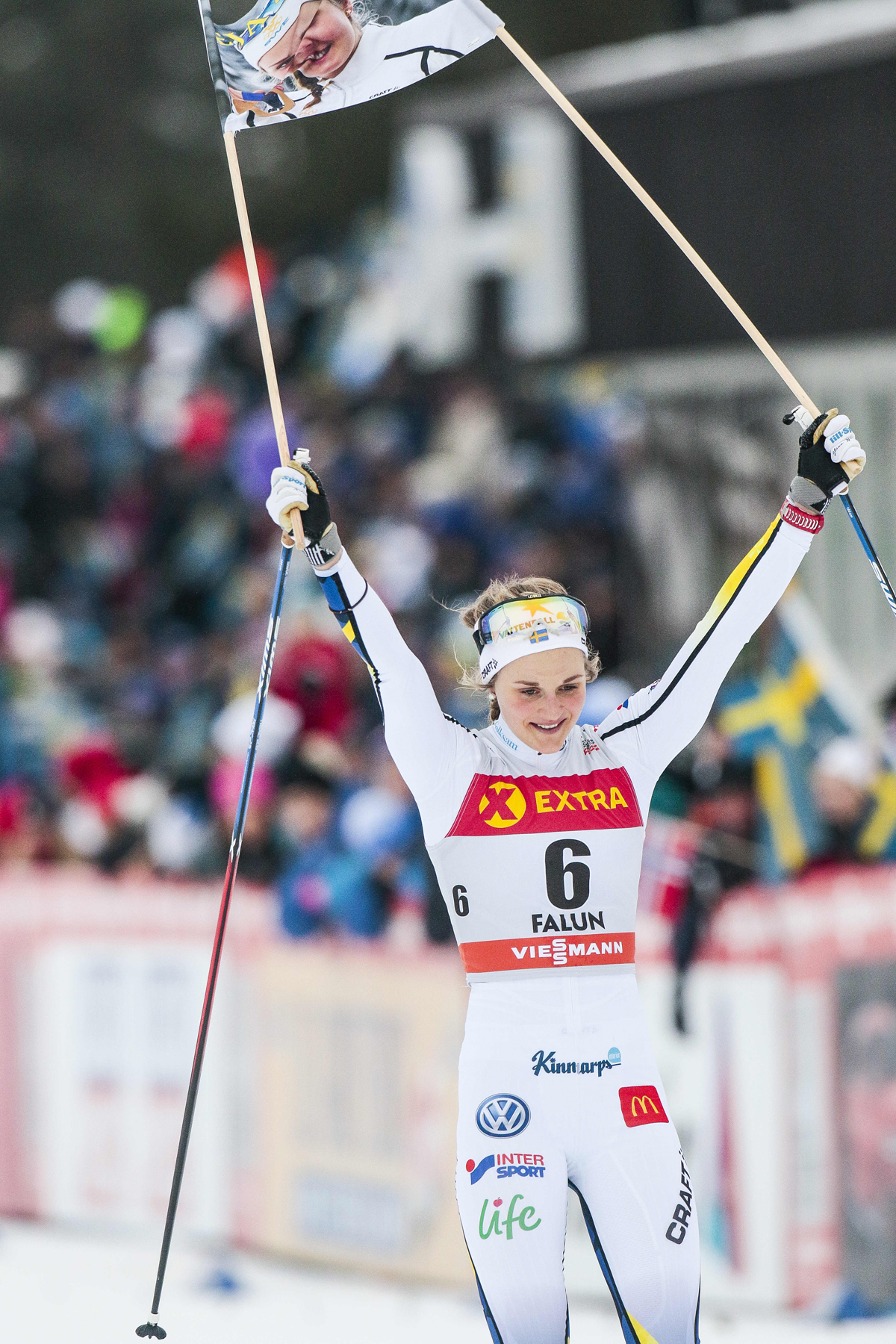
Count them: Five USST Women in the Heats
Falun’s sprint course profile is unrelenting. Three punchy climbs made up the spine of the course: the first a bit taller than the second, with a third kicker thrown in just to get athletes to burning-fumes level before the finishing straight.
From the get-go, the U.S. women were in it. Sophie Caldwell (USST) qualified in third (+1.23) behind Norway’s Marit Bjørgen, who skied the fastest qualifier in 3:00.64.
Jessie Diggins (USST) qualified fifth (+2.39), Sadie Bjornsen (USST) 17th (+5.04), Randall 26th (+6.64), and Ida Sargent (USST) popped the qualifying bubble as the last qualifier in 30th (+8.28). Rosie Brennan (USST) finished 37th (+10.9), and Liz Guiney (Craftsbury Green Racing Project) 56th (+32.87).
The sprint narrative begins with the 56 starters. Then the 30 qualifiers play a bit of bracketology from the quarterfinals to the semifinals and ultimately the finals. And for North American fans, it was a quarterfinal spectacle — five quarters and a different U.S. skier in each.
Sargent
Let’s start with Sargent.
“Today left me confident in my fitness but very frustrated with some of the tactical decisions that I made today and really wish that I could have a redo,” Sargent wrote in an email.
She explained she “exploded” in the qualifier by starting too full throttle.
“I was actually pretty surprised that I made it considering how I skied the last few hundred meters. So I was just happy to have snuck in with the 30th spot and happy to have another shot in the heats,” she added.
In her heat, Sargent said she believed Nilsson, the day’s winner, and Norway’s Ingvild Flugstad Østberg would have set a more sustained and blistering pace. The U.S. skier’s tactic was to temper her off-the-line pace, ski relaxed, find openings, and improve her position on the hills.
“Unfortunately that didn’t turn out to be the case and I couldn’t ever find an opening,” Sargent wrote. “Our heat felt like it was a slow pace with surges which was not what I was expecting with Ingvild and Stina in it … It was so much stop and go and I felt like I skied twice as far as everyone else in the heat trying to find somewhere to go.”
Sargent placed 25th overall after finishing fifth in her heat. (The Vermont-based skier is also ranked 25th on the overall World Cup sprint list).
Bjornsen
From the gun, Bjornsen was controlled in her effort.
“I decided to not be as aggressive off the start, but kind of be just toward the front of the pack,” Bjornsen said on the phone. “But unfortunately I just kept getting behind traffic jams.”
U.S. Ski Team Women’s Coach Matt Whitcomb reiterated Bjornsen’s sentiments.
“The target was to kind of have a medium-fast start, which we define as ending up third out of the start,” Whitcomb said. “It puts you in a good move to respond to attacks, you’re not the tail of the dog, you can drive your own pace, and make your own decisions, rather than respond to what everybody else does.”
The course appeared to congest skiers rather than spread them out. If a skier could not kill off the front, it was a poker-like gambit of where to ski and when to make a move. Add into the sprinting calculus five other bodies and 10 other skis swinging in wide-V formation. Room to maneuver was scarce.
“I have tried a lot of different tactics in sprinting this year,” Bjornsen said of what she’d take away from the day. “I have tried times where I have been leading and then hadn’t had the sprint at the end. I have tried time where I don’t go as aggressive at the start and try to find it at the end, and I feel like I haven’t yet figured out what works best for me yet.”
The post-race quarterbacking is fruitful in that it allows athletes to reflect on positive outcomes the next time out. But right down to the wire, Bjornsen’s heat was tight, and it’s hard to fathom what type of distance a sprinter covers in a fleeting 0.64 seconds. But that’s how close fourth place Bjornsen was to the heat winner Weng.
“I haven’t had a huge success in sprinting yet this year, but I also know that .64 seconds is such a small margin,” Bjornsen reflected. “As soon as I figure that out I know things are going to work, because I think I have a tendency in my past to get stronger in each heat. I guess I am just waiting for that … or more like figure out what exactly is my strength in sprinting and where to make the most value of it.”
Bjornsen finished 19th on the day and is currently 18th in the overall World Cup.
Caldwell
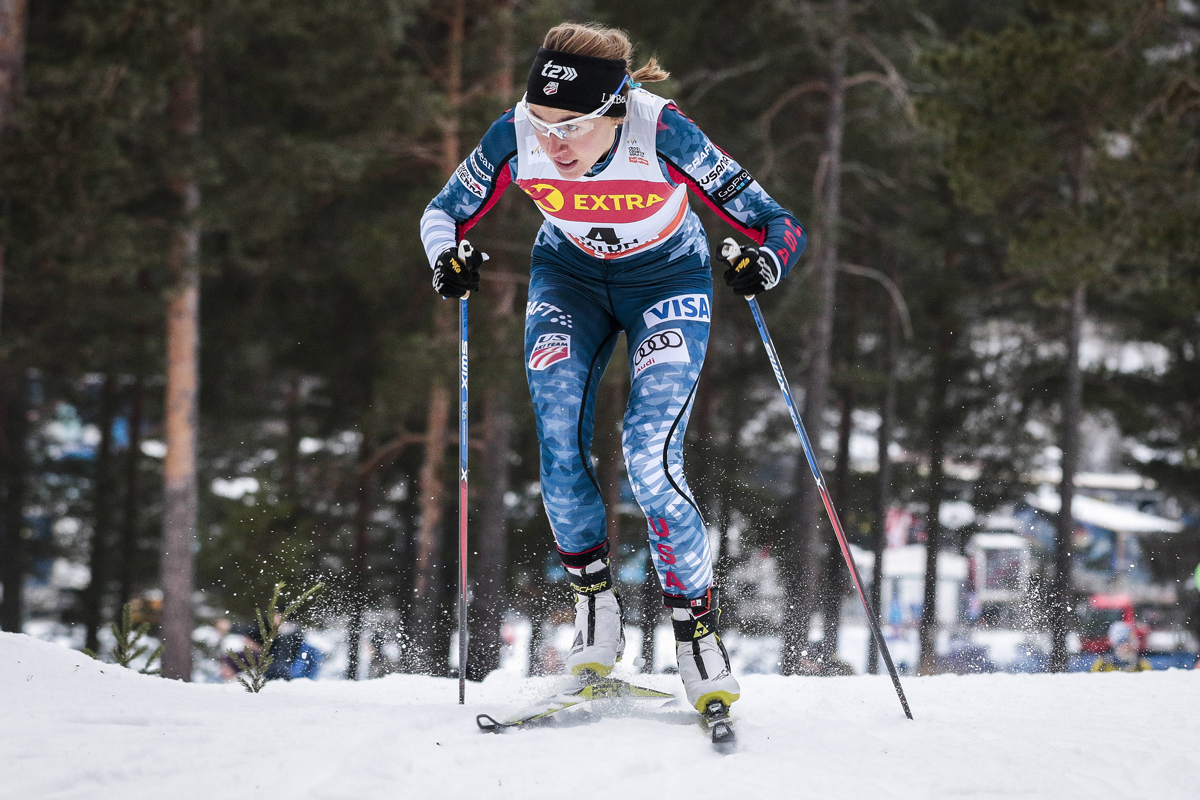
Earlier in the week, Caldwell wrote in an email she was feeling a bit tired. The later half of her week was easy. Yesterday consisted of a few speeds and ski testing.
“I felt great in speeds and felt like my energy had come around, so I was looking forward to today,” Caldwell explained.
The body may be a prescient crystal ball: the Vermonter charged in the qualifier and chose to contest the fifth heat. That heat featured Bjørgen and Parmakoski.
“I wanted to position myself well in the start and stay in the top half of the group going into the long downhill where there was quite a draft,” Caldwell noted.
Caldwell remained near the front up and over the first two climbs. Bjørgen being Bjørgen made a go on the second climb. But Caldwell received a perceptive tip prior to her heat.
“My tech, Oleg, had talked to me before the heat and said it was important to be patient because people were standing up and free skating too early, but if you stayed in your tuck, you could suck people up on the second half of the flat,” Caldwell wrote of the guidance. Off that second hill Caldwell remained slipstream-low and she sucked up the ground to Bjørgen.
“I think I executed that well, but in hindsight, I should have moved to the side of Marit to try to make a pass or at the very least block the people who were benefiting from the draft behind me,” Caldwell wrote.
On the last hill Parmakoski passed Caldwell and then it was a fight in the remaining meters to the finish. Caldwell ended up fourth in her heat (+0.79) for 16th on the day..
Whitcomb, who had a moment to process the race, had some insight into skier tactics moving forward.
“I think where [Sophie] ran into trouble was coming into the stadium on Marit,” Whitcomb said. “I think she needed to check her mirrors a little bit — she had a train that was catching up that had covered a 20 meter gap, and when you cover a gap like that you come in with some speed, and she really needed to shut down the lane on the left, not in an unethical way, but she needed to occupy that space so she didn’t get shut down herself later.”
Caldwell is currently 11th in the sprint standings.
“I’m confident in my fitness right now and was really happy with my qualifier,” she wrote in an email. “I went for it on a hard course and I got a little tired, but it was still a solid day with some positive takeaways.”
And then there were two
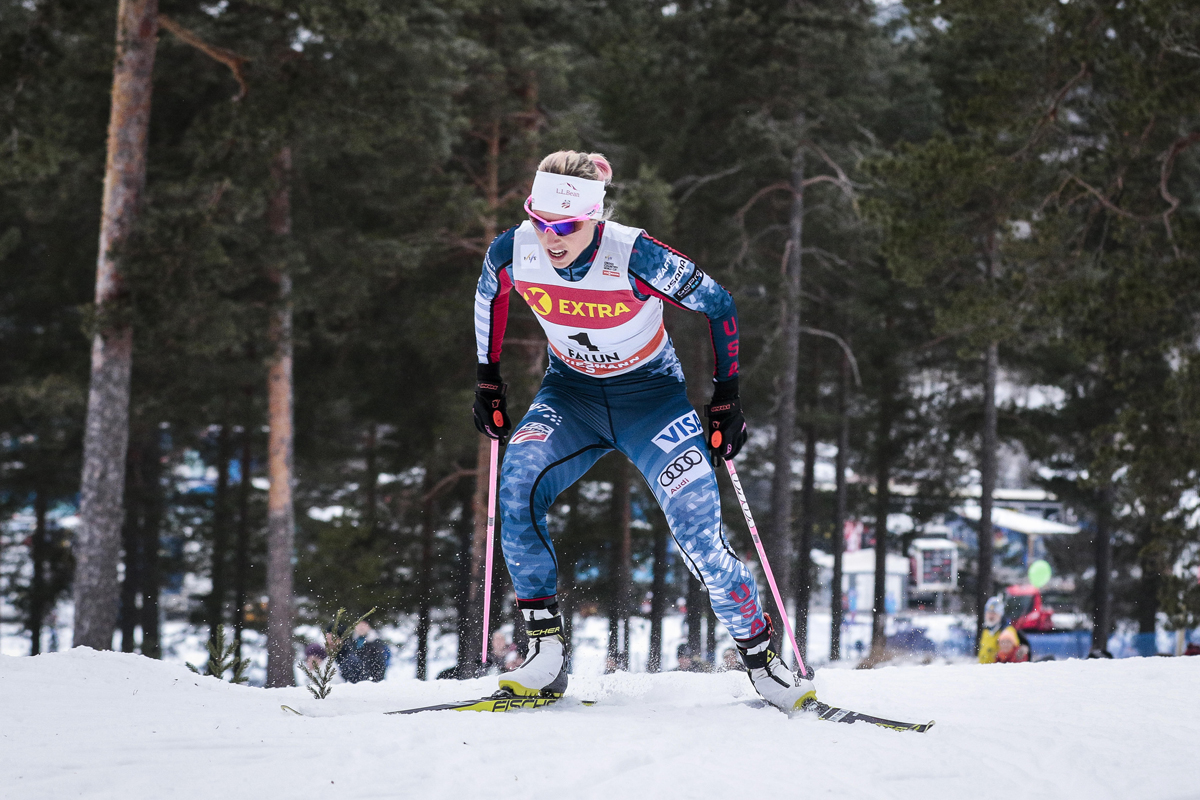
Of the five USST skiers in the heats, two advanced to the semis: Diggins and Randall.
Diggins’s year has been defining. She’s fifth overall in the World Cup. That ranking means one thing — consistency. And when it comes to a turbocharged gear, Diggins doesn’t disappoint
In her quarterfinal, she crested the first hill in third.
“She had an incredible move in her quarterfinals, after a slow start she saw a window, and was able to move into the three/four spot at the top of the course,” Whitcomb said. “And that’s a hard thing to do in a World Cup field, especially in the quarterfinals where everybody is still fresh.”
Before the second hill, Diggins V2’d into second, and almost matched Falla’s speed to the top. For the remainder, Falla and Diggins were untouchable. Onto the semis.
In Randall’s quarterfinal heat, she skied big and smooth. Until about 2:30 into the race, Randall hadn’t made her decisive move. But when she did, she gained a spot from third to second and accelerated on the final hill. She finished second.
Paired in the semifinals, Diggins and Randall both appeared poised to advance to the final round. Then cresting a hill, Diggins’s skis simply went too wide and she was down. Sweden’s Hanna Falk then got tangled in her skis. After picking herself up Diggins finished fifth in the heat, ahead of a still-recovering Falk, and landed 10th overall.
“I’m really proud of how I skied today,” Diggins emailed. “My energy felt awesome, my tactics worked well and I felt like my leg speed was where it needs to be with the World Championships coming up! Of course, with my eyes on the podium it would have been awesome to NOT have a spill, but overall I’m happy with where my body is.”
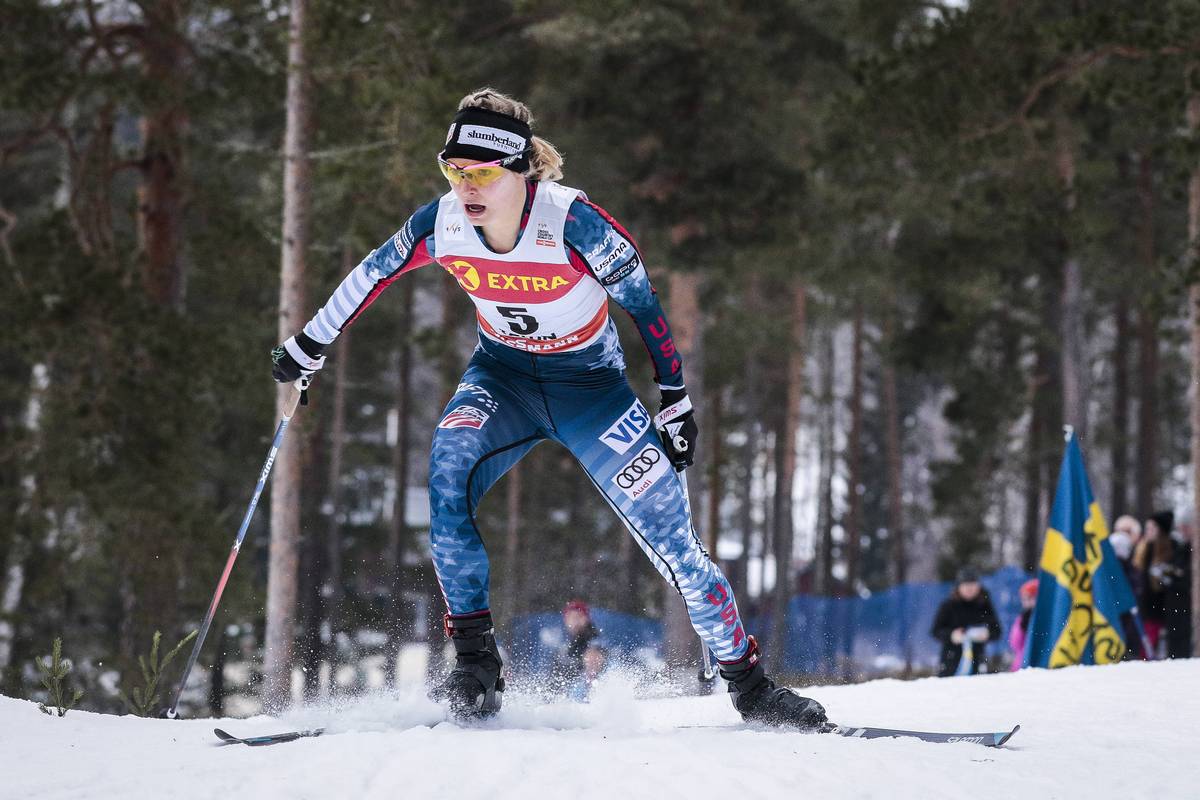
Whitcomb noted Diggins’s ability to be in control of her destiny as she navigates a six-skier race.
“It was really encouraging to see that she’s in absolute control of where she is in this pack, and it came down to a silly error at the end, and fortunately we can laugh about it, and move on,” he said.
Randall placed second in the semifinal, earning an automatic spot in the final, where she ended up fifth (+2.56).
“We were seeing responses out of Kikkan, she put the pedal down, almost like what she was used to when she was winning globes, and getting an actual speed response,” Whitcomb said. “She’s getting very close.”
Winner of three sprint globes, Randall knows fast and she knows sustained fast. And according to her, that speed is coming.
“I just kind of skied tactically made sure to have good energy for the second half of the race and felt like I had just another gear today in terms of that real high end sprint speed,” Randall said on the phone. “And that’s a gear that was definitely missing earlier in the season. So still not back to full strength, but I am getting more and more glimpses of the shape that I used to have a couple of years ago.”
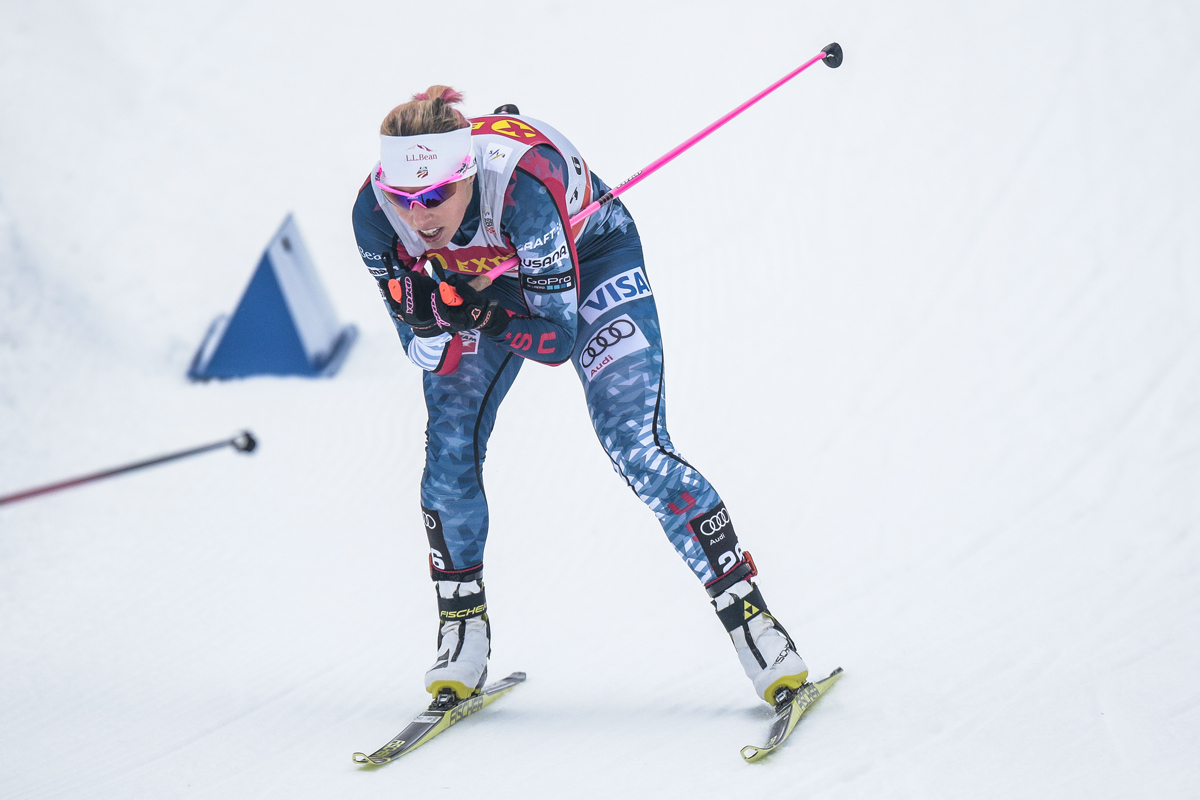
The unknowns have been many. Will there be a return to form for Randall? And if so, how long until she’s there?
Asked if she had nerves or questions in her first final in nearly 24 months, Randall affirmed she is answering questions that undoubtedly have been on her mind.
“It is a really funny position to be in because I certainly know what’s possible for myself, having had the success in the past,” Randall said. “But it has been very much a rebuilding year starting from the ground up this season, so every race I go into I am not sure what gears are going to be there. So going in, I was just ecstatic to be in the final … but I would say my race feeling and my confidence is still building. This one makes a really good difference now that we go into a bit of training block and World Championships is just a month away.”
It’s a big step forward for the Alaskan mom.
Racing continues Sunday in Falun with the men’s and women’s classic mass starts.
Jason Albert
Jason lives in Bend, Ore., and can often be seen chasing his two boys around town. He’s a self-proclaimed audio geek. That all started back in the early 1990s when he convinced a naive public radio editor he should report a story from Alaska’s, Ruth Gorge. Now, Jason’s common companion is his field-recording gear.



